The seven-man line defenses are defensive alignments in American football which may refer to:
The seven-man line defenses are defensive alignments in American football which may refer to:
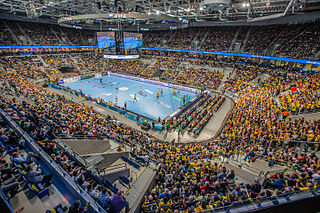
Handball is a team sport in which two teams of seven players each pass a ball using their hands with the aim of throwing it into the goal of the opposing team. A standard match consists of two periods of 30 minutes, and the team that scores more goals wins.
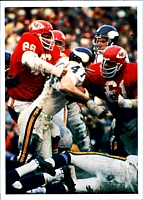
Super Bowl IV was an American football game played on January 11, 1970, at Tulane Stadium in New Orleans, Louisiana. It was the fourth and final AFL–NFL World Championship Game in professional football prior to the AFL–NFL merger taking effect the following season. The American Football League (AFL) champion Kansas City Chiefs defeated the National Football League (NFL) champion Minnesota Vikings by the score of 23–7. This victory by the AFL squared the Super Bowl series with the NFL at two games apiece as the two leagues merged after the game.

A cornerback (CB) is a member of the defensive backfield or secondary in gridiron football. Cornerbacks cover receivers most of the time, but also blitz and defend against such offensive running plays as sweeps and reverses. They create turnovers through hard tackles, interceptions, and deflecting forward passes.

Linebacker (LB) is a playing position in gridiron football. Linebackers are members of the defensive team, and line up three to five yards behind the line of scrimmage and the defensive linemen. They are the "middle ground" of defenders, playing closer to the line of scrimmage than the defensive backs (secondary), but farther back than the defensive linemen.
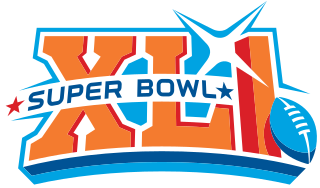
Super Bowl XLI was an American football game played between the American Football Conference (AFC) champion Indianapolis Colts and the National Football Conference (NFC) champion Chicago Bears to decide the National Football League (NFL) champion for the 2006 season. The Colts defeated the Bears by the score of 29–17. The game was played on February 4, 2007, at Dolphin Stadium in Miami Gardens, Florida. This was the first and to date, only Super Bowl win for an AFC South team.
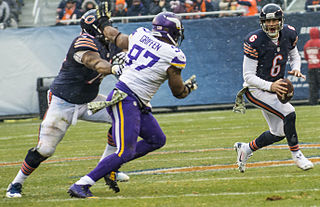
Defensive end (DE) is a defensive position in the sport of gridiron football.

The 46 defense is an American football defensive formation, an eight men in the box defense, with six players along the line of scrimmage. There are two players at linebacker depth playing linebacker technique, and then three defensive backs. The 46 defense was originally developed and popularized with the Chicago Bears by their defensive coordinator Buddy Ryan, who later became head coach of the Philadelphia Eagles and Arizona Cardinals.

In sports, a starting lineup is an official list of the set of players who will participate in the event when the game begins. The players in the starting lineup are commonly referred to as starters, whereas the others are substitutes or bench players.

In American football, the 3–4 defense is a common defensive alignment consisting of three down linemen and four linebackers. It is called a "base defense" because it will readily switch to other defensive alignments as circumstances change. Alternatively, some defenses use a 4–3 defense: four down linemen and three linebackers.

Zone coverage is a defense scheme in gridiron football used to protect against the pass.

In American football, a 4–3 defense is a defensive alignment consisting of four down linemen and three linebackers. It is called a "base defense" because it is the default defensive alignment used on "base downs". However, defenses will readily switch to other defensive alignments as circumstances change. Alternatively, some defenses use a 3–4 defense.
The following terms are used in American football, both conventional and indoor. Some of these terms are also in use in Canadian football; for a list of terms unique to that code, see Glossary of Canadian football.

In American football, the 5–2 defense is a defensive alignment consisting of five down linemen and two linebackers.

The 1960 Michigan Wolverines football team was an American football team that represented the University of Michigan in the 1960 Big Ten Conference football season. In its second year under head coach Bump Elliott, Michigan compiled a 5–4 record, finished in fifth place in the Big Ten, and outscored opponents by a combined total of 133 to 84.
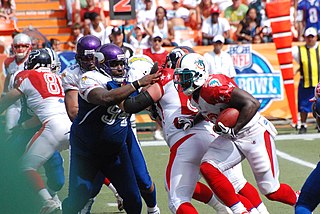
A defensive tackle (DT) is a position in American football that will typically line up on the line of scrimmage, opposite one of the offensive guards; however, he may also line up opposite one of the tackles. Defensive tackles are typically the largest and strongest of the defensive players. Depending on a team's individual defensive scheme, a defensive tackle may be called upon to fill several different roles. These roles may include merely holding the point of attack by refusing to be moved, or penetrating a certain gap between offensive linemen to break up a play in the opponent's backfield. If a defensive tackle reads a pass play, his primary responsibility is to pursue the quarterback, or simply knock the pass down at the line if it is within arm's reach. Other responsibilities of the defensive tackle may be to pursue the screen pass or drop into coverage in a zone blitz scheme. In a traditional 4–3 defense, there is no nose tackle. Instead there is a left and right defensive tackle. Some teams, especially in the National Football League (NFL), have a nose tackle in this scheme, but most of them do not.

The 7–2–2 defense or seven-box defense, used seven "down linemen", or players on the line of scrimmage at the time of the snap, two linebackers, and two safeties. Amos Alonzo Stagg invented the seven-box defense in 1890 at Springfield College. At that time, most teams were using a nine-man line on defense, and there were only three downs and no forward passes. The 7–2–2 was the base defense used by Knute Rockne at Notre Dame, as well as Mike Donahue at Auburn. Into the late 1930s, the 7–2–2 was still commonly employed inside the defender's thirty-yard line. It was considered "very strong against a running attack, but rather weak defensively against passes." The 7–2–2 was also employed when the opponent was expected to punt.

The 7–1–2–1, or seven-diamond defense, used seven "down linemen", or players on the line of scrimmage at the time of the snap, one linebacker, two safeties relatively close to the line and one safety farther downfield. The formation was created by Minnesota Golden Gophers coach Henry L. Williams in 1903, reputedly to stop Michigan back Willie Heston. By some accounts in the mid-1930s, the 7–1–2–1 was considered "almost obsolete" due to its weakness against the forward pass, whereas the 7–2–2 defense was still considered viable. Yet Bill Arnsparger notes the use of the seven-diamond from the 1940s into the 1960s, as a defensive adjustment to the common wide tackle 6 defenses of the time. Further, the form of the 7 diamond as derived from a wide tackle 6, with a more compact line spacing than the 1930s era 7 man lines, shows a marked similarity to the 46 defense of Buddy Ryan.

Super Bowl 50 was an American football game to determine the champion of the National Football League (NFL) for the 2015 season. The American Football Conference (AFC) champion Denver Broncos defeated the National Football Conference (NFC) champion Carolina Panthers, 24–10. The game was played on February 7, 2016, at Levi's Stadium in Santa Clara, California, in the San Francisco Bay Area. As this was the 50th Super Bowl game, the league emphasized the "golden anniversary" with various gold-themed initiatives during the 2015 season, as well as suspending the tradition of naming each Super Bowl game with Roman numerals, so the logo could prominently feature the number 50 in more familiar Arabic numerals.

The 2005 Pittsburgh Steelers–Indianapolis Colts playoff game was a National Football League (NFL) Divisional Round playoff game between the sixth-seeded Pittsburgh Steelers and the top-seeded Indianapolis Colts, taking place during the 2005–06 NFL playoffs at the RCA Dome in Indianapolis, Indiana on January 15, 2006.